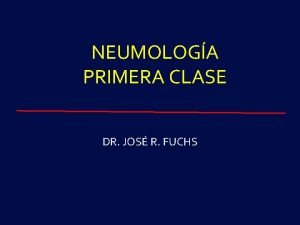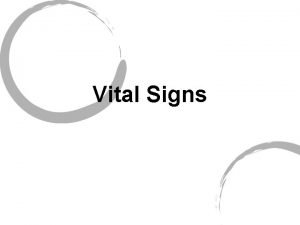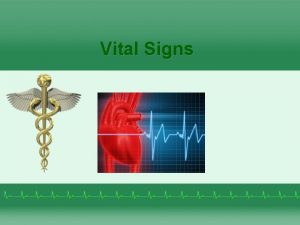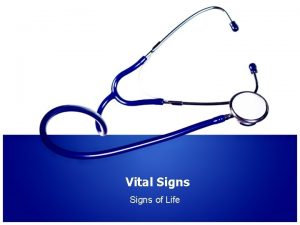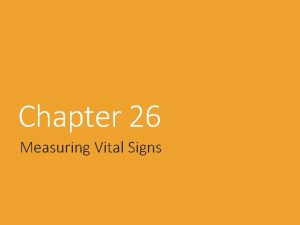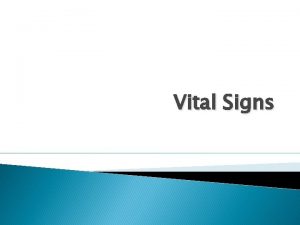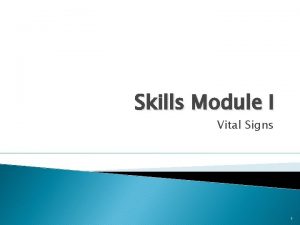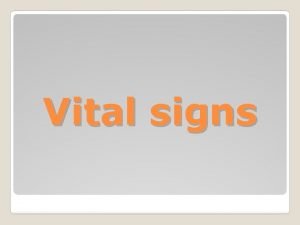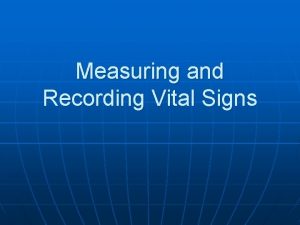Vital Signs Foundation Standard 10 Technical Skills Apply













- Slides: 13


Vital Signs • *Foundation Standard 10: Technical Skills • Apply technical skills required for all career specialties and demonstrate skills and knowledge as appropriate • 10. 11 Apply procedures for measuring and recording vital signs including the normal ranges (temperature, pulse, respirations, blood pressure, pain). 2

Vital Signs • Temperature • Pulse • Respiration • Blood pressure 10. 11 Apply procedures for measuring and recording vital signs including the normal ranges (temperature, pulse, respirations, blood pressure, pain). 3

Thermometers • Types • Oral- mouth • Tympanic-ear • Axillary- armpit • Rectal- rectum • Temporal- forehead 10. 11 Apply procedures for measuring and recording vital signs including the normal ranges (temperature). 4

Temperatures Route Normal Temperature Range Sites Oral 97°F (36. 1°C) to 99°F (37. 2°C) Mouth Tympanic 99. 1 o. F(37. 3 ºC) to 99. 6 ºF(37. 6 o. C) Ear Rectal 99. 1 o. F(37. 3 ºC) to 99. 6 ºF(37. 6 o. C) Rectum Axillary 97. 6 ºF(36. 4 o. C) to 98. 1 o. F(36. 7 ºC) Armpit Temporal 97. 6 o. F (36. 4 o. C) to 98. 1 o. F (36. 7 o. C) Forehead 10. 11 Apply procedures for measuring and recording vital signs including the normal ranges (temperature). 5

Procedure • Record to the nearest 0. 1 o • Oral- wait 15 minutes after eating or drinking • Tympanic- primarily for children • Rectal- wear gloves, lubricate thermometer, insert ½” for infants and 1” for adults • Axillary probe must touch skin • Tympanic- must cross temporal artery 10. 11 Apply procedures for measuring and recording vital signs including the normal ranges (temperature). 6

Pulse • Number of times heart beats per minute • Normal resting pulse range. Newborns (0 -3 months) 100 -150 Infants (3 -6 months) 90 -120 Infants (6 -12 months 100 -160 Children ages 1 -10 70 -130 Children over age 10 and adults 60 -100 Well-conditioned athletes 40 -60 10. 11 Apply procedures for measuring and recording vital signs including the normal ranges (pulse). 7

Procedure • Locate pulse (radial-adult, brachial- infant), press lightly with index and third fingers • Irregular pulse- note • Tachycardia- > 100 bpm • Bradycardia- < 60 bpm • Weak • Irregular 10. 11 Apply procedures for measuring and recording vital signs including the normal ranges (pulse). 8

Respiration • Respiration- 1 inhalation and 1 exhalation • Normal resting respiration rate Approximate Age Range Newborn 0 -5 months 6 -12 months 1 -3 years 3 -5 years 6 -10 years 11 -14 years 15 -20 years Adults Respiratory Rate 30 -50 25 -40 20 -30 15 -30 12 -20 12 -30 16 -20 10. 11 Apply procedures for measuring and recording vital signs including the normal ranges (respirations). 9

Procedure • Count number of breaths per minute • Look, listen with a stethoscope, feel • Note • Effort (shallow or deep) • Hyperventilation- excessive rate • Dyspnea- painful breathing • Tachypnea- rapid breathing 10. 11 Apply procedures for measuring and recording vital signs including the normal ranges (respirations). 10

Blood Pressure • Systolic pressure- ventricles are contracting, first heart sound when taking blood pressure, top number • Diastolic pressure- ventricles are relaxing, last heart sound when taking blood pressure, bottom number Blood pressure = Systolic Pressure Diastolic Pressure 10. 11 Apply procedures for measuring and recording vital signs including the normal ranges (blood pressure). 11

Blood Pressure Ranges Age Systolic Diastolic 1 -12 months 1 -4 years 75 -100 80 -110 50 -70 50 -80 3 -5 years 6 - 13 years 13 -18 years Adult 80 -110 85 -120 95 -140 <120 120 -139 140 -159 50 -80 55 -80 60 -90 <80 80 -89 90 -99 Normal Prehypertension Stage 1 hypertension Adult >160 >100 Stage 2 hypertension 10. 11 Apply procedures for measuring and recording vital signs including the normal ranges (blood pressure). 12

Procedure • Equipment- Sphygmomanometer (inflatable cuff, pressure bulb, and manometer) and stethoscope • Measuring blood pressure • Place cuff on the upper arm above the brachial pulse site • Inflate cuff 200 mm. Hg • Release the air in cuff and listen for the first heartbeat (systolic pressure) and the last heartbeat (diastolic pressure) • Record results with systolic as the top number and diastolic as the bottom number 10. 11 Apply procedures for measuring and recording vital signs including the normal ranges (blood pressure). 13
 Signs signs everywhere signs meaning
Signs signs everywhere signs meaning Composition of urine slideshare
Composition of urine slideshare Cross apply vs outer apply
Cross apply vs outer apply Employability skills
Employability skills Foundation standard 4 employability skills
Foundation standard 4 employability skills Foundation standard 4 employability skills
Foundation standard 4 employability skills Foundation standard 4 employability skills
Foundation standard 4 employability skills Foundation standard 4 employability skills
Foundation standard 4 employability skills Capacidad vital y capacidad vital forzada
Capacidad vital y capacidad vital forzada Vital signs definition
Vital signs definition Vital signs normal rate
Vital signs normal rate Respiration as a vital sign
Respiration as a vital sign Vital signs information
Vital signs information Vital signs chart normal range
Vital signs chart normal range








